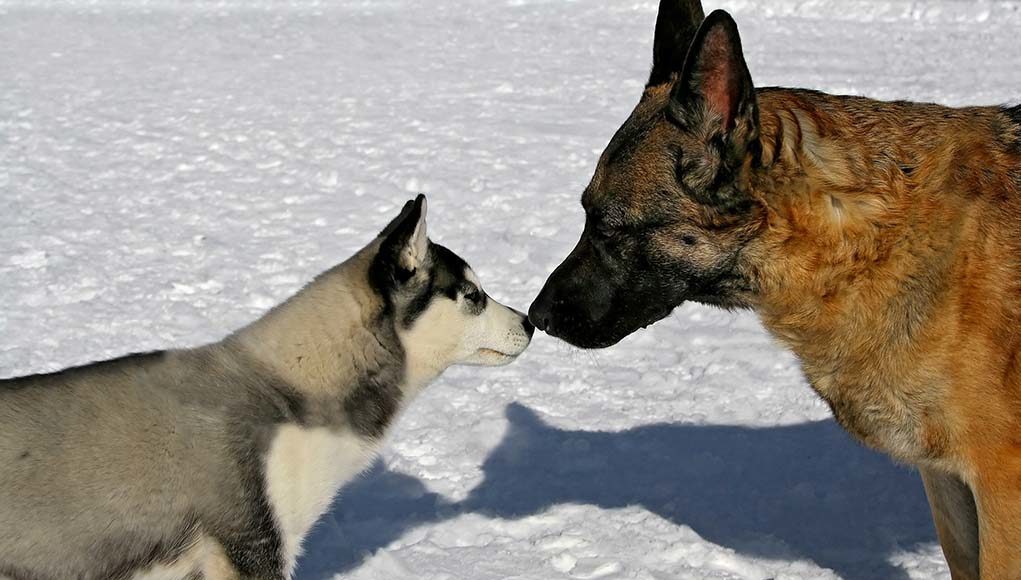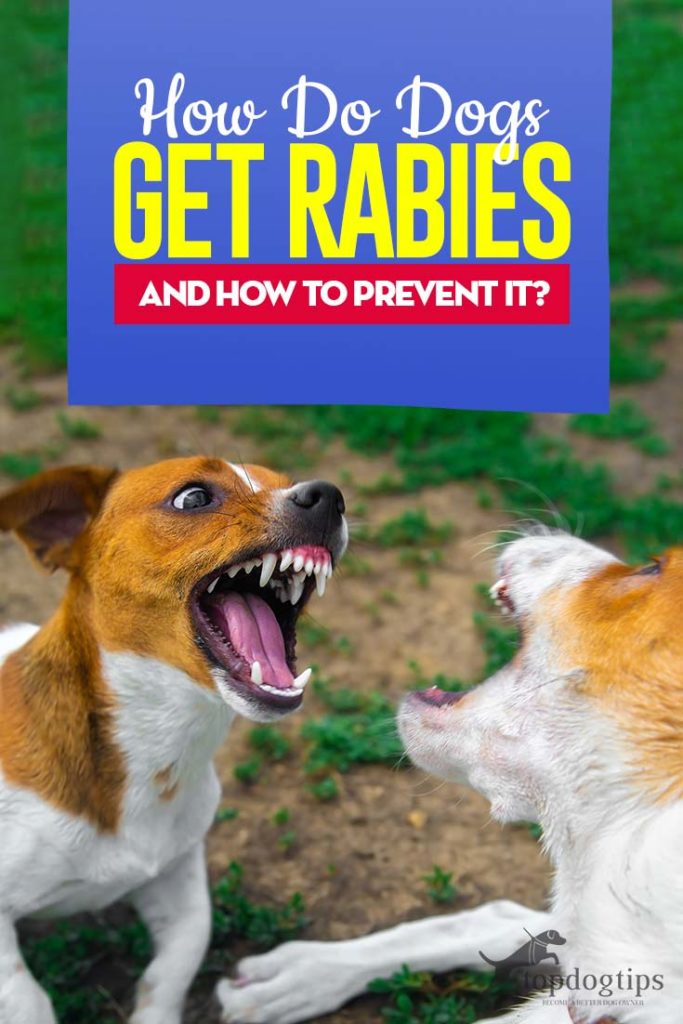A bullet-shaped rabies virus (RABV) belongs to the family Rhabdoviridae and the genus Lyssavirus (1). The degree of its pathogenicity (the ability of that particular virus to cause disease) is not too high. That means only 17 people out of 100 bitten by an infected dog will get sick. However, all of them will die without taking a rabies immune globulin and vaccine.
Table of Contents
Rabies occurs in over 150 countries in the world (2). The indicative data is that over 60,000 people die every year because of this disease, and over 40% of them are children and elders (3). Since today, domestic dogs have been the main transmitters of viruses in almost 99% of cases (4). The crucial question is, how do dogs get rabies, and how do they prevent it?
Transmission and How Do Dogs Get Rabies
Rabies is transmitted to the dog almost exclusively by the bite of another animal and virus-containing saliva (5). In rare cases, the dog may get this disease after scratching when the saliva of the rabid animal comes in contact with the open wound.
Therefore, the most likely scenario of your dog getting rabies is through contact with another domesticated or wild-infected animal. These instances usually occur in more rural areas and with pet owners going on camping or hiking trips.
In even more seldom instances, other ways dogs get rabies are also possible (6, 7):
- contamination of a dog's mucous membranes like their eyes, nose or mouth;
- aerosol transmission
- corneal and organ transplantations.
As soon as the virus enters a dog's body, it begins multiplying near the place of bite right away. It is still possible to stop the infection at this point. However, once it invades the nerve cells, then the disease becomes incurable. Eventually, the virus goes along the nerve to the brain and keeps continuing to multiply there. It's fatal from this point on.
Rabid animals contain considerable amounts of virus in their salivary glands. After biting, they secrete saliva and transmit the rabies virus to a healthy animal or human.
Animals that are most common carriers of rabies (8, PDF):
| Domestic animals | Wild animals |
| Dogs | Bats |
| Cats | Foxes |
| Horses | Raccoons |
| Cows | Skunks |
| Goats | Beavers |
| Ferrets | Monkeys |
| Rabbits | Coyotes |
Incubation period
The average period before the appearance of the first symptoms of rabies in dogs is about three weeks to three months. However, some exceptions are noted when the incubation period takes more than two years or just four days.
Basically, when the bite is closer to the dog's brain, you can expect the first symptoms to appear faster. Once the disease occurs, it is 100% fatal without exceptions.
Symptoms
The literal translation of the word rabies means ‘madness' because of the abnormal mental state of both an infected animal and a human. The most horrible things connected with this disease, called ‘demonic illness,' are symptoms.
The first ones are not overly characteristic and usually include fever, lethargy, burning and tingling at the bite site, vomiting, and muscle weakness.
There are two types of rabies: Furious rabies and Paralytic rabies.
Furious rabies. It is a more common form of rabies in dogs and typically includes symptoms such as:
- Aggression
- Biting
- Loss of fear
- Loss of appetite
- Difficulty in swallowing
- Restlessness and insomnia
- Excess vocalization
- Dilated pupils
Paralytic rabies. This is a less aggressive form and takes longer to develop, but it also includes severe symptoms, such as:
- Decreased activity
- Incoordination
- The weakness of hind limbs
- Inability to close the mouth
- Inability to swallow
- Paralysis
Keep in mind that not all dogs show all the signs of rabies infection. However, once neurological abnormalities are noticed in the dog, rabies should always be considered.
Diagnosis
There is still no test that can reliably detect rabies in a dog in an early stage. After that, the detection of the virus is not complicated. The best option is to use tissue from the cerebellum and brain stem after euthanizing the animal.
The test itself takes less than two hours. Still, the results in the US are available within 24 to 72 hours since it takes time to remove the samples and send them to an adequate veterinary diagnostic laboratory for diagnosis.
Every year, vets test more than 120,000 animals in the US. Results show that 6% of them are rabid on average – 1% of domestic pets and farm animals and 10% of wild animals.
Prevention
Since there is no cure for this horrible disease, prevention is a crucial step in protecting both people and animals.
In humans, once symptoms appear, rabies is fatal. A person dies due to respiratory and heart failure approximately a week after the first symptoms appear. Luckily, rabies in people is preventable nowadays thanks to the so-called PEP or post-exposure prophylaxis if applied within 48 hours after the bite.
Vaccines are the best way to stop rabies
In dogs, regular vaccination is the safest way to prevent rabies virus (9). It is scientifically proven that it is possible to control rabies only if at least 70% of dogs are vaccinated (10, 11).
The puppy needs to receive the first vaccine at three months. The re-vaccination is required after one year. After that, regular vaccination of pet dogs is mandatory once every one to three years, depending on each state's state laws.
The ambitious global strategic plan of WHO is to eradicate rabies deaths in humans by 2030 by reaching a sufficient number of dogs vaccinated.
Additionally, dogs from high-risk countries can't enter the US without a valid rabies vaccination certificate showing they are vaccinated and fully immunized.
Although the dog is vaccinated, it is necessary to visit the vet for a booster vaccine after exposure to an infected animal. There is also organized vaccination of particular species of wildlife in the US to prevent rabies.
Avoid contact with injured or dead wildlife
Not letting your dog touch wild animals without proper precautions is a crucial way to prevent rabies. It is also necessary to keep your dogs away from injured or dead wildlife.
You must supervise the dog while outdoors, especially in rural areas. Some of the rabbits or squirrels your pet likes to chase may be paralyzed or behave unusually, which can be a sign of rabies. The same is true with other pet dogs; you need to prevent them from biting your dog.
You are strongly advised to visit a veterinarian and report each case of a sick, too-friendly, or highly aggressive wild animal, especially if it bites your or another dog.
The procedure after the rabid animal bit your dog
The first reaction after your pet dog has been in contact with a rabid animal is to wash the wound with water and soap and call the vet.
Since the rabies virus remains alive for approximately two hours on the skin of a bitten pet dog, it is necessary to avoid touching it without protective clothing and gloves.
The next step is to contact the local health department to report the incident and follow the given recommendations.
Always stay informed
Be aware of the danger and the species of animals that are transmitters of rabies, and in particular, the wildlife that lives in your local vicinity or wherever you take your dog for a walk.
For example, avoid walking your dog near places where bats live since they are the primary carriers of this disease in the US. The local health department can provide information about species that are the more common rabies carriers in each state as well.
Conclusion
Rabies is an endemic disease throughout the US, except Hawaii. Fortunately, the disease has been reduced by 98% in dogs and 95% in humans in the Americas since 1983.
Besides dogs, the most common carriers of infection here are raccoons, foxes, bats, and skunks. Approximately 300 to 500 domestic pets get rabies every year. Be careful not only with your dog but yourself as well since there are at least two cases of human infection per year.
READ NEXT: How Many Shots Do Puppies Need?
Want to share this?














